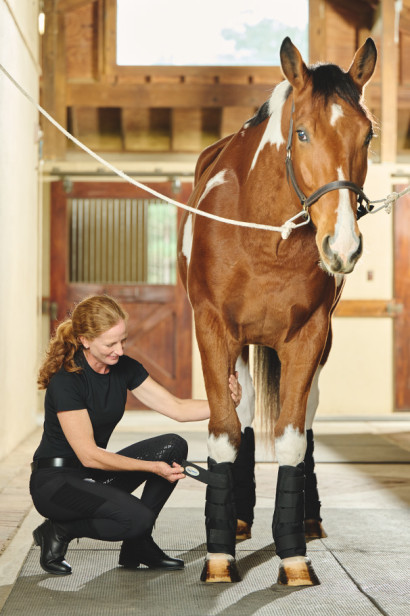The Power of Equine Therapy for Anxiousness, PTSD, and Emotional Recovery
The Power of Equine Therapy for Anxiousness, PTSD, and Emotional Recovery
Blog Article
Just How Laser Therapy in Equine Therapy Is Changing Veterinary Treatment for Equines
Laser therapy has become a transformative method in equine vet care, offering a non-invasive solution that expedites recovery and improves overall wellness. Leveraging exact light wavelengths, this innovative treatment boosts cellular regrowth, minimizes inflammation, and minimizes discomfort. Its efficacy expands from musculoskeletal injuries to persistent conditions like osteoarthritis, significantly boosting wheelchair and life quality for equines. The portability and versatility of laser treatment devices better highlight their expanding indispensability amongst veterinarians. As we discover the elaborate technicians and real-world successes, the profound influence on equine clinical techniques ends up being progressively evident.
Recognizing Laser Therapy

The modern technology behind laser treatment is grounded in the principle of photochemistry, where photons are absorbed by chromophores within cells, resulting in enhanced ATP manufacturing and inflection of responsive oxygen types (Equine Therapy). This, consequently, advertises cellular expansion, minimizes swelling, and speeds up recovery. Veterinary practitioners make use of various kinds of lasers, consisting of low-level lasers (LLLT) and high-power Course IV lasers, depending upon the details restorative goals and the nature of the equine condition being treated
Various laser wavelengths and power setups are meticulously picked to target numerous tissue depths and achieve wanted professional end results. Safety and security procedures are vital, as improper usage can bring about thermal damages or suboptimal restorative effects. Thus, a comprehensive understanding of laser treatment's devices and applications is vital for its efficient implementation in equine vet method.
Benefits for Horse Wellness
The myriad advantages of laser therapy for equine health and wellness encompass boosted healing, discomfort reduction, and enhanced movement. This innovative treatment technique leverages specific wavelengths of light to penetrate cells, stimulating cellular feature and promoting fast cells repair work. The non-invasive nature of laser treatment ensures very little stress and anxiety and discomfort for the equine, facilitating a smoother healing procedure.
Enhanced healing is one of the primary benefits, as laser treatment increases mobile regrowth and collagen synthesis. Pain reduction is achieved through the anti-inflammatory effects of laser therapy, which reduces swelling and minimizes the manufacturing of pain-inducing chemicals.
By reducing swelling and discomfort, and improving tissue repair, laser treatment assists in bring back joint function and muscular tissue adaptability. Therefore, laser therapy stands as a transformative device in modern-day equine veterinary treatment.
Typical Conditions Dealt With
Laser therapy has actually emerged as a functional treatment alternative for a variety of usual equine conditions. In addition, laser therapy is reliable for conditions like osteo arthritis, where it helps minimize joint inflammation and advertise tissue repair service.
Wound management is one more location where laser therapy has actually revealed significant pledge. Chronic wounds or slow-healing abscess can be particularly difficult in steeds, however laser treatment enhances mobile regrowth and improves blood flow, hence accelerating the recovery process. In addition, laser treatments have actually been efficiently employed in handling unguis problems such as laminitis and abscesses, minimizing pain and advertising quicker recuperation.

Modern Technology Behind Laser Treatment
Past the myriad conditions treatable with laser therapy, the technology itself benefits closer examination. At the heart of laser treatment is making use of certain wavelengths of light to permeate tissues and elicit organic actions. These wavelengths, normally ranging from 600 to 1000 nanometers, are selectively absorbed by chromophores in the skin, muscular tissue, and various other tissues, prompting a waterfall of cellular events.
Laser tools made use of in veterinary medicine frequently utilize low-level laser treatment (LLLT) or cool laser treatment. Unlike high-powered surgical lasers, these devices run at lower energy levels, maximizing restorative benefits while minimizing thermal damages. The power from the laser light boosts adenosine triphosphate (ATP) go to these guys production, improves cellular metabolic rate, and increases tissue repair processes.

Success Stories and Situation Researches

Showcasing the concrete advantages of laser treatment, countless success tales and study illuminate its transformative influence on equine health and wellness. One such situation entails a thoroughbred racehorse suffering from chronic tendonitis. Conventional treatments generated very little enhancement, yet after incorporating laser treatment right into the routine, the steed showed substantial decreases in swelling and discomfort within weeks, inevitably going back to affordable racing.
One more compelling example includes a dressage steed detected with serious pain in the back, limiting its efficiency. A veterinary group employed low-level laser treatment (LLLT) to target the irritated areas, resulting in marked renovation in adaptability and a remarkable decline in pain. Over a number of sessions, the equine regained its peak form, showcasing the efficiency of laser treatment in dealing with musculoskeletal concerns.
Furthermore, a research study conducted at a leading equine clinic checked out 50 equines with different soft tissue injuries treated with laser treatment. The results were striking: 85% of the steeds demonstrated accelerated recovery times and enhanced mobility. These instances highlight the flexibility and performance of laser treatment in equine medicine, offering a non-invasive, scientifically-backed strategy to improving recovery and efficiency in equines.
Conclusion
Laser treatment is reinventing equine veterinary care by providing a non-invasive therapy that speeds up healing, minimizes inflammation, and alleviates discomfort. With its efficiency in dealing with a series of company website conditions, from bone and joint injuries to chronic disorders like osteoarthritis, this modern technology dramatically improves equine health and wellness and wheelchair. The transportability and versatility of laser treatment better underscore its transformative effect on veterinary methods, strengthening its function as an essential great site device in contemporary equine medical care.
Report this page